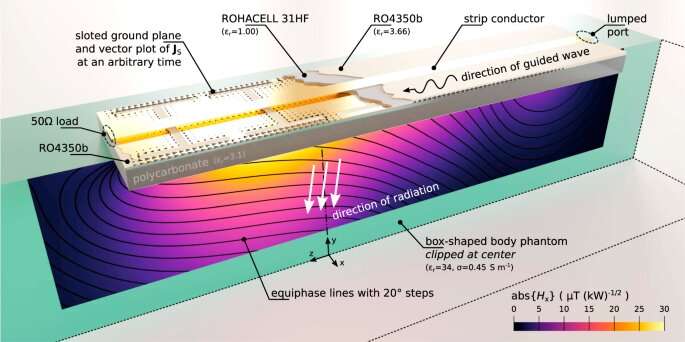The exciting slotted microstrip line radiates into a box-shaped human body phantom for body MRI RF excitation. The color plot shows the normalized magnitude of the simulated Hx distribution, while black contours represent wavefronts in the conductive medium. Calculated surface current density distribution on the slotted ground plane is shown with black arrows.Nature Communications (2021). DOI: 10.1038/s41467-020-20708-w
Scanners applied in research use not just one antenna that emits and receives the signal, but several of them, which can cause severe burns to inner tissues and organs. Thus, researchers are forced to power scanners with less voltage, which negatively affects the quality of their studies. Now, ITMO physicists, together with their colleagues from the M-Cube consortium, have created the first ever leaky-wave antennas for MRI scanners. The device can conduct body organ diagnostics without risks for patient health while also raising the quality of images acquired in research scanners.
The special antennas are based on the principle of broadband radiation. The prototype was produced using standard printed circuit board technology, which reduced the cost and labor intensity of its production. MRI technology is based on irradiating patients with electromagnetic waves of a certain frequency. Inside the scanner, resonances occur in the human body that result in the acquired image. The main problem is maintaining a high-quality image without doing any harm to the patient's body.
"Our idea is that we have many small antennas connected in series with a wave propagating through them. Each element emits a portion of the power, so that together they form the total radiation. Thanks to the method of leaky waves (which are non-resonant), it is possible to reduce the heating and make the scanning safe for patients," explains Georgiy Solomakha, a Ph.D. student at ITMO's Faculty of Physics and Engineering and main author of the paper.
Similar antennas are used in radio direction finding and radar, and ITMO researchers have specially adapted them to be applied in the MRI technology.
According to Georgiy Solomakha, the solution could open new research applications of MRI technology. As the new antenna technology significantly decreases heating, it will be possible to raise the power used by the scanner without any risks. This, in turn, will improve the quality of resulting images, which means that it will be possible to more closely study the functioning of inner organs or track the development of diseases.
More information: G. Solomakha et al. A self-matched leaky-wave antenna for ultrahigh-field magnetic resonance imaging with low specific absorption rate, Nature Communications (2021). DOI: 10.1038/s41467-020-20708-w
Journal information: Nature Communications
Provided by ITMO University
























